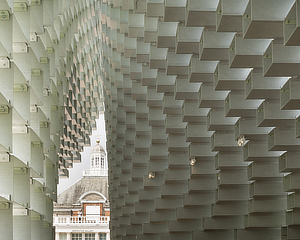 The Serpentine reveals the designs for its expanded Architecture Programme for 2016: the 16th annual Pavilion designed by Bjarke Ingels Group (BIG) (Copenhagen/New York) and four newly commissioned Summer Houses by Kunlé Adeyemi – NLÉ (Amsterdam/Lagos), Barkow Leibinger (Berlin/New York), Yona Friedman (Paris) and Asif Khan (London). The Summer Houses are inspired by Queen Caroline’s Temple, a classical style summer house built in 1734 and a stone’s throw from the Serpentine Gallery. The Serpentine reveals the designs for its expanded Architecture Programme for 2016: the 16th annual Pavilion designed by Bjarke Ingels Group (BIG) (Copenhagen/New York) and four newly commissioned Summer Houses by Kunlé Adeyemi – NLÉ (Amsterdam/Lagos), Barkow Leibinger (Berlin/New York), Yona Friedman (Paris) and Asif Khan (London). The Summer Houses are inspired by Queen Caroline’s Temple, a classical style summer house built in 1734 and a stone’s throw from the Serpentine Gallery. 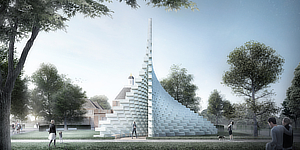 Introducing contemporary architecture to a wider audience, the Serpentine Architecture Programme presents a unique exhibition of contemporary international architecture in the built form, rather than through an exhibition of models, drawings and plans. Each of the five architects, aged between 36 and 93, have not completed a permanent structure in the UK. Introducing contemporary architecture to a wider audience, the Serpentine Architecture Programme presents a unique exhibition of contemporary international architecture in the built form, rather than through an exhibition of models, drawings and plans. Each of the five architects, aged between 36 and 93, have not completed a permanent structure in the UK.
|
| » AR dossier on Serpentine Gallery Pavilion 2016 « |
|
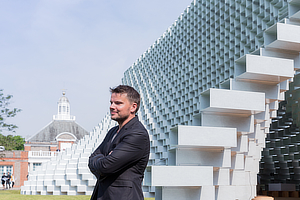 Architect’s StatementBjarke Ingels Group (BIG) Architect’s StatementBjarke Ingels Group (BIG)
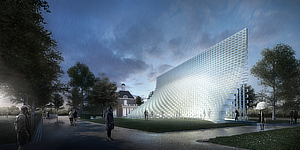 For the Serpentine Pavilion 2016, we have attempted to design a structure that embodies multiple aspects that are often perceived as opposites: a structure that is free-form yet rigorous, modular yet sculptural, both transparent and opaque, both solid box and blob.We decided to work with one of the most basic elements of architecture: the brick wall. Rather than clay bricks or stone blocks, the wall is erected from pultruded fibreglass frames stacked on top of each other. The wall is then pulled apart to form a cavity within it, to house the events of the Pavilion’s programme. This unzipping of the wall turns the line into a surface, transforming the wall into a space. A complex three-dimensional environment is created which can be explored and experienced in a variety of ways, inside and outside. At the top, the wall appears like a straight line, while the bottom, it forms a sheltered valley at the entrance of the Pavilion and an undulating hillside towards the Park.The unzipped walls creates a cave-like canyon lit through the fiberglass frames and gaps between the shifted boxes, as well as throgh the translucent resin of fiberglass. As a result, the shifting overlaps as well as the movement and presence of people outside create a lively play of light and shadow on the cave walls within.The materials include wooden floors and extruded Fiberline profiles, providing every surface with a warm glow and linear texture – from the mesh of woven glass fibres to the undulating lines of the grain of the wood.This simple manipulation of the archetypal space-defining garden wall creates a presence in the park that changes as you move around and as you move through it. The North-South elevation of the Pavilion is a perfect rectangle. The East-West elevation is an undulating sculptural silhouette. Towards the East-West, the Pavilion is completely opaque and material. Towards the North-South, it is an entirely transparent and pratically immaterial. As a result, presence becomes absence, orthogonal becomes curvilinear, structure becomes gesture, and box becomes blob. For the Serpentine Pavilion 2016, we have attempted to design a structure that embodies multiple aspects that are often perceived as opposites: a structure that is free-form yet rigorous, modular yet sculptural, both transparent and opaque, both solid box and blob.We decided to work with one of the most basic elements of architecture: the brick wall. Rather than clay bricks or stone blocks, the wall is erected from pultruded fibreglass frames stacked on top of each other. The wall is then pulled apart to form a cavity within it, to house the events of the Pavilion’s programme. This unzipping of the wall turns the line into a surface, transforming the wall into a space. A complex three-dimensional environment is created which can be explored and experienced in a variety of ways, inside and outside. At the top, the wall appears like a straight line, while the bottom, it forms a sheltered valley at the entrance of the Pavilion and an undulating hillside towards the Park.The unzipped walls creates a cave-like canyon lit through the fiberglass frames and gaps between the shifted boxes, as well as throgh the translucent resin of fiberglass. As a result, the shifting overlaps as well as the movement and presence of people outside create a lively play of light and shadow on the cave walls within.The materials include wooden floors and extruded Fiberline profiles, providing every surface with a warm glow and linear texture – from the mesh of woven glass fibres to the undulating lines of the grain of the wood.This simple manipulation of the archetypal space-defining garden wall creates a presence in the park that changes as you move around and as you move through it. The North-South elevation of the Pavilion is a perfect rectangle. The East-West elevation is an undulating sculptural silhouette. Towards the East-West, the Pavilion is completely opaque and material. Towards the North-South, it is an entirely transparent and pratically immaterial. As a result, presence becomes absence, orthogonal becomes curvilinear, structure becomes gesture, and box becomes blob.
|
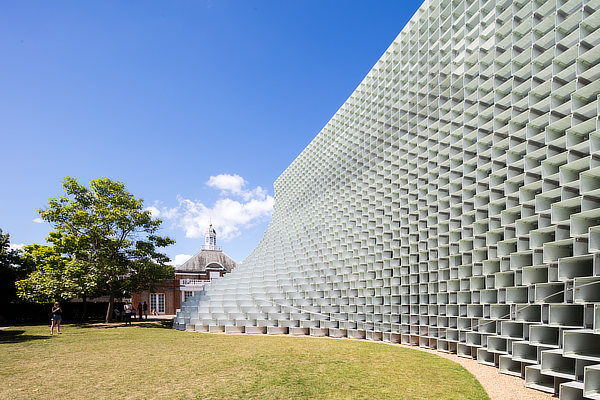 |
|
|
Summer Houses
The Summer Houses are a significant addition to the Serpentine’s programme of commissioning international architects to design a structure for the Gallery’s lawn as an exhibition of architecture in a built- form. The designs for the Pavilion and Summer Houses consider the relationships between each of the five structures, the Serpentine Gallery building and the landscape of Kensington Gardens.
Queen Caroline's Temple is a classical-style summer house overlooking The Long Water, east of Lancaster Walk in Kensington Gardens. It was designed for Queen Caroline, for whom The Long Water was created in 1734-5 and is attributed to William Kent. Some of the graffiti inside the Temple dates back to 1821 when the Park was first opened every day for visitors. It was later converted into a park keeper's home, but restored in 1976. |
|
 Architect’s StatementKunlé Adeyemi – NLÉ Architect’s StatementKunlé Adeyemi – NLÉ
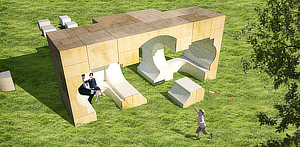 With a play on architecture, our design aims to fulfil the simple primary purpose of a Summer House: a space for shelter and relaxation. The design is based on projecting an inverse replica of the historic Queen Caroline’s Temple – a tribute to its robust form, space and material, recomposed into a new architectural language. With a play on architecture, our design aims to fulfil the simple primary purpose of a Summer House: a space for shelter and relaxation. The design is based on projecting an inverse replica of the historic Queen Caroline’s Temple – a tribute to its robust form, space and material, recomposed into a new architectural language.
By rotating the Temple’s interior space, we expose the structure’s neo-classical plan, proportions and form. Using prefabricated building blocks assembled from rough sandstone similar to those used in building the Temple, in contrast with a soft interior finish, our composition generates basic elements of architecture - a room, a doorway and a window - for people to interact with the building, the environment and with one another. The carved out void, homely interior and fragmented furniture blocks create comfortable spaces for people to eat, rest or play – in and around the house - all through summer. |
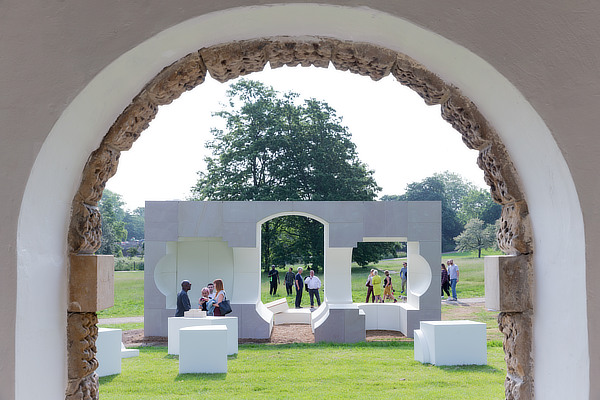 |
» gallery of photos [8 images] and drawings [3 images] «
|
|
|
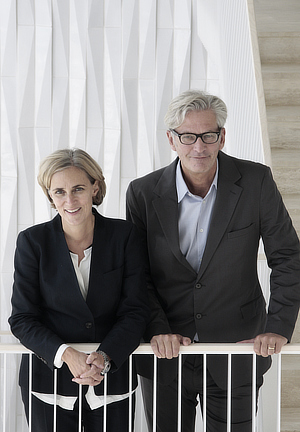 Architect’s StatementBarkow Leibinger Architect’s StatementBarkow Leibinger
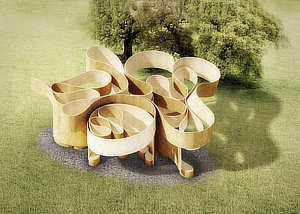 Queen Caroline’s Temple, an 18th Century historical summer house attributed to William Kent and situated in proximity to the Serpentine Gallery, stands – seemingly without purpose – facing a large meadow. A second Pavilion, today extinct, also designed by Kent was situated on a nearby man-made mountain constructed from the dredging of the artificial The Long Water. This small pavilion rotated mechanically 360 degrees at the top of the hill, offering various panoramic views of the Park and, reciprocally, different views of itself when seen from the Park. It was meant both to be visible in the Park and a structure from which to survey its surroundings. The little mountain and house disappeared at some point in history.With this absent structure in mind, we have designed a Summer House in-the-round. Standing free with all its sides visible, and conceived as a series of undulating structural bands, it is reminiscent of a blind contour drawing (a drawing executed without lifting the pencil up from the paper and only looking at the subject). The logic of generating a structure from loops is a self-generating one and comes from the idea of coiling material in your hands then stacking the coils upon each other. The horizontal banding recalls the layered coursing of Queen Caroline’s Temple, despite its idiosyncratic nature.The new Summer House is organised as four structural bands beginning with a bench level attached to the ground, on which is a second band of three C-shaped walls crowned by a third and fourth level that forms a cantilevered roof, a tree-like canopy over the smaller footprint defined by the undulating loops of bench wood. The Summer House is constructed from plywood and timber, materials intrinsically in harmony with the looping geometry of the structure. Queen Caroline’s Temple, an 18th Century historical summer house attributed to William Kent and situated in proximity to the Serpentine Gallery, stands – seemingly without purpose – facing a large meadow. A second Pavilion, today extinct, also designed by Kent was situated on a nearby man-made mountain constructed from the dredging of the artificial The Long Water. This small pavilion rotated mechanically 360 degrees at the top of the hill, offering various panoramic views of the Park and, reciprocally, different views of itself when seen from the Park. It was meant both to be visible in the Park and a structure from which to survey its surroundings. The little mountain and house disappeared at some point in history.With this absent structure in mind, we have designed a Summer House in-the-round. Standing free with all its sides visible, and conceived as a series of undulating structural bands, it is reminiscent of a blind contour drawing (a drawing executed without lifting the pencil up from the paper and only looking at the subject). The logic of generating a structure from loops is a self-generating one and comes from the idea of coiling material in your hands then stacking the coils upon each other. The horizontal banding recalls the layered coursing of Queen Caroline’s Temple, despite its idiosyncratic nature.The new Summer House is organised as four structural bands beginning with a bench level attached to the ground, on which is a second band of three C-shaped walls crowned by a third and fourth level that forms a cantilevered roof, a tree-like canopy over the smaller footprint defined by the undulating loops of bench wood. The Summer House is constructed from plywood and timber, materials intrinsically in harmony with the looping geometry of the structure. |
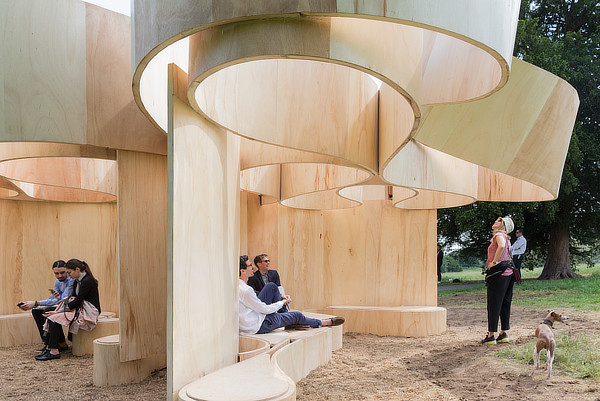 |
» gallery of photos [7 images] and drawings [5 images] «
|
|
|
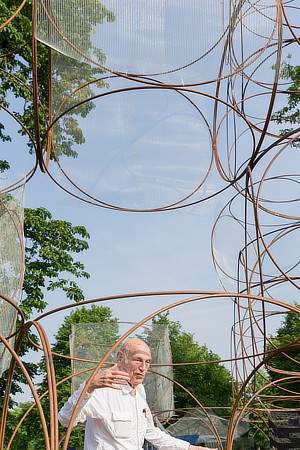 Architect’s StatementYona Friedman Architect’s StatementYona Friedman
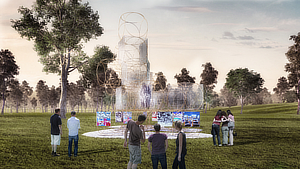 The proposed Summer House builds upon my project La Ville Spatiale (Spatial City) begun in the late 1950s. The manifesto for this project, published in 1959, was based on two pillars or principles: firstly, a mobile architecture that could create an elevated city space and enable the growth of cities while restraining the use of land; secondly, the use of modular structures to allow people to live in housing of their own design.The Serpentine Summer House is a ‘space-chain’ structure that constitutes a fragment of a larger grid structure, originally conceived for La Ville Spatiale. It is a modular structure that can be disassembled and assembled in different formations and compositions. This original structure, designed for bearing light loads, consists of 30 cubes measuring 1.80 x 1.80 x 1.80 m3, built with metal rings of 1.80 m in diameter and assembled into a skeleton. Some of the cubic voids are enclosed with panels of polycarbonate.The Summer House is a space-chain construction of 4+1 levels. It is composed of cubes defined by 6 circles of 1.85 metre in diameter and made with steel tubes of 16 mm in diameter. The cubes are composed into irregular geometrical shapes that rest on the ground.The Summer House is a modular structure that can be disassembled and assembled in different formations and compositions. In this particular case, it is only the ground level that is accessible to visitors. But with slight technical changes, such as adjusting some of its constituting elements, all levels could be made visible to visitors.The project is conceived to serve as a multi-level ‘showcase’ for exhibitions. Part of the cubes can support transparent polycarbonate panels, which can be used as showcases containing artworks, plants or other objects. The Summer House is essentially a movable museum and exhibition. The proposed Summer House builds upon my project La Ville Spatiale (Spatial City) begun in the late 1950s. The manifesto for this project, published in 1959, was based on two pillars or principles: firstly, a mobile architecture that could create an elevated city space and enable the growth of cities while restraining the use of land; secondly, the use of modular structures to allow people to live in housing of their own design.The Serpentine Summer House is a ‘space-chain’ structure that constitutes a fragment of a larger grid structure, originally conceived for La Ville Spatiale. It is a modular structure that can be disassembled and assembled in different formations and compositions. This original structure, designed for bearing light loads, consists of 30 cubes measuring 1.80 x 1.80 x 1.80 m3, built with metal rings of 1.80 m in diameter and assembled into a skeleton. Some of the cubic voids are enclosed with panels of polycarbonate.The Summer House is a space-chain construction of 4+1 levels. It is composed of cubes defined by 6 circles of 1.85 metre in diameter and made with steel tubes of 16 mm in diameter. The cubes are composed into irregular geometrical shapes that rest on the ground.The Summer House is a modular structure that can be disassembled and assembled in different formations and compositions. In this particular case, it is only the ground level that is accessible to visitors. But with slight technical changes, such as adjusting some of its constituting elements, all levels could be made visible to visitors.The project is conceived to serve as a multi-level ‘showcase’ for exhibitions. Part of the cubes can support transparent polycarbonate panels, which can be used as showcases containing artworks, plants or other objects. The Summer House is essentially a movable museum and exhibition. |
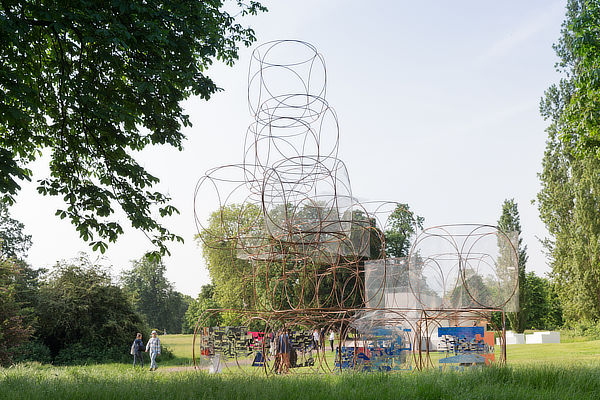 |
» gallery of photos [8 images] and drawings [2 images] «
|
|
|
 Architect’s StatementAsif Khan Architect’s StatementAsif Khan
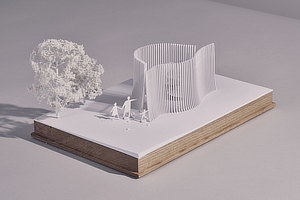 The Summer House takes a circular form where the circumference has been unpeeled to connect us and the Temple to a picturesque moment left hidden by William Kent almost 300 years ago.Through sun path analysis I realised that Kent aligned the temple toward the direction of the rising sun on 1st March 1683, Queen Caroline’s birthday. This effect would have been amplified by the reflection off the newly created Serpentine lake. We can imagine that The Serpentine lake itself may have been designed to amplify this annual moment, a landscape-sized mirror to reflect the sun, a possibility which John Rennie’s 1826 bridge obscures.In our Summer House a polished metal platform and roof provide an intimate experience of this lost moment for the visitor.Three ‘rooms’ of differing spatial quality gently enfilade together like those in the Temple. These are articulated by an undulating line of timber staves which create enclosure and direct views. The ground is a continuous gravel landscape punctuated by stepping stones, subtly elevating and measuring the visitor’s approach when entering the interior.As the structure meets the gravel it gently blends the horizontal and vertical, to appear as if the Summer House might have grown out of the ground.The project is designed to offer new experiences of the Park through dialogue with Queen Caroline’s Temple and the surrounding scenery. The Summer House takes a circular form where the circumference has been unpeeled to connect us and the Temple to a picturesque moment left hidden by William Kent almost 300 years ago.Through sun path analysis I realised that Kent aligned the temple toward the direction of the rising sun on 1st March 1683, Queen Caroline’s birthday. This effect would have been amplified by the reflection off the newly created Serpentine lake. We can imagine that The Serpentine lake itself may have been designed to amplify this annual moment, a landscape-sized mirror to reflect the sun, a possibility which John Rennie’s 1826 bridge obscures.In our Summer House a polished metal platform and roof provide an intimate experience of this lost moment for the visitor.Three ‘rooms’ of differing spatial quality gently enfilade together like those in the Temple. These are articulated by an undulating line of timber staves which create enclosure and direct views. The ground is a continuous gravel landscape punctuated by stepping stones, subtly elevating and measuring the visitor’s approach when entering the interior.As the structure meets the gravel it gently blends the horizontal and vertical, to appear as if the Summer House might have grown out of the ground.The project is designed to offer new experiences of the Park through dialogue with Queen Caroline’s Temple and the surrounding scenery. |
 |
» gallery of photos [8 images] and drawings [3 images] «
|
|
|
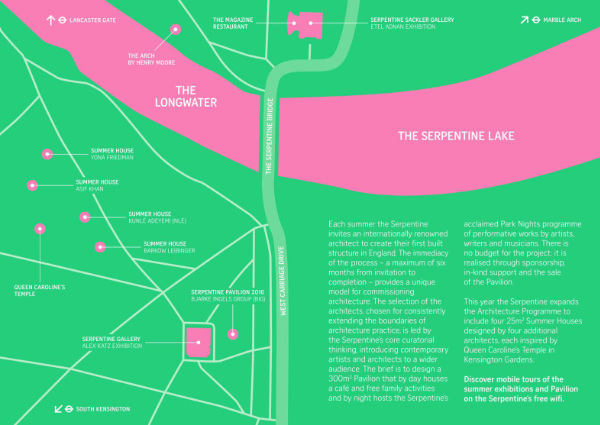 |
|
Serpentine Pavilion History
The Serpentine's Pavilion commission, conceived in 2000 by Director Julia Peyton-Jones, has become an international site for architectural experimentation and has presented projects by some of the world's greatest architects. Each Pavilion is sited on the Serpentine Gallery's lawn for four months and the immediacy of the commission – taking a maximum of six months from invitation to completion – provides a unique model worldwide. The selection of the architects, chosen for consistently extending the boundaries of architecture practice, is led by the Serpentine’s core curatorial thinking, introducing contemporary artists and architects to a wider audience. The brief is to design a 300-square-metre Pavilion that is used as a café by day and a forum for learning, debate and entertainment at night.
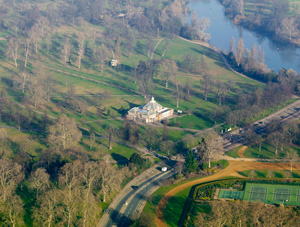 Serpentine Pavilion architects to date are: Serpentine Pavilion architects to date are:
Installation period: 10 June / 9 October 2016

See others Serpentine Gallery Pavilions
Credits
Photos © Jim Stephenson, Iwan Baan, Luke Hayes, Garry Knight, John Offenbach
Drawings and models © Bjarke Ingels Group (BIG), Kunlé Adeyemi – NLÉ, Barkow Leibinger, Yona Friedman, Asif Khan
Videos by Serpentine Gallery
Text edited by Serpentine Gallery
Courtesy of Serpentine Gallery |